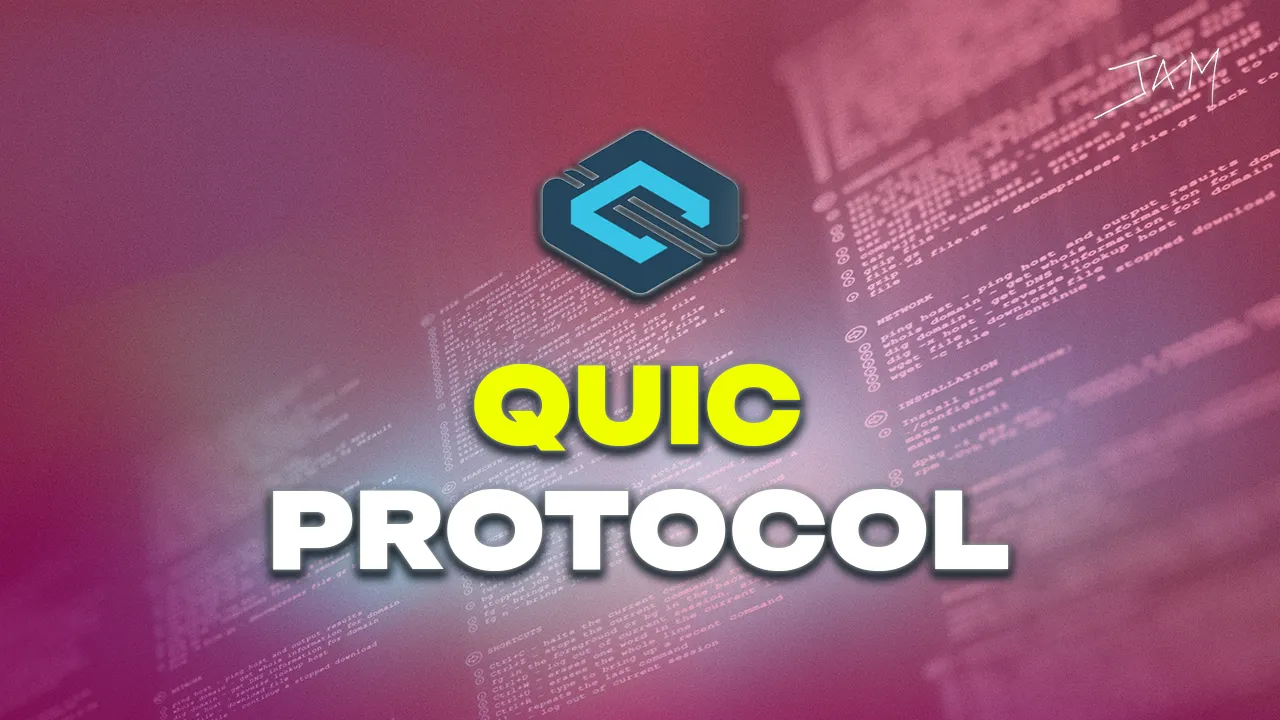The QUIC (Quick UDP Internet Connections) protocol represents a significant advancement in transport layer technology, promising to improve the performance of connection-oriented web applications. Initially developed by Google and later standardized by the Internet Engineering Task Force (IETF), QUIC is designed to overcome many of the limitations inherent in the Transmission Control Protocol (TCP). This article delves into the intricacies of the QUIC protocol, exploring its architecture, advantages, applications, and impact on the broader internet ecosystem.
Why QUIC protocol is crucial for JAM Chain?
The QUIC protocol is crucial to the JAM Chain’s networking architecture. It allows for direct, persistent point-to-point connections between validators, eliminating the need for traditional socket-based communication and avoiding gossip protocols. This design ensures efficient and reliable communication across a large number of validators within the JAM ecosystem, enhancing performance and scalability, especially in environments with complex transactionless operations like those in JAM.
Introduction to QUIC Protocol
QUIC is a general-purpose transport layer network protocol that has garnered significant attention since its inception. It was first implemented and deployed by Google in 2012, with a public announcement in 2013. Designed to enhance the performance of web applications, QUIC operates by establishing multiplexed connections between endpoints using the User Datagram Protocol (UDP). This approach is intended to obsolete TCP for many applications, earning QUIC the occasional nickname of “TCP/2”.
The name “QUIC” was initially an acronym for “Quick UDP Internet Connections“. However, in the IETF’s usage, it has since evolved into a standalone term, no longer representing an acronym. The protocol is now a key component in modern web technologies, particularly in conjunction with HTTP/3, where it plays a crucial role in reducing latency and improving the efficiency of data transmission.
The Evolution of QUIC Protocol
The development of QUIC began with a focus on addressing the limitations of TCP, particularly in the context of web applications. TCP, while reliable, is often criticized for its inefficiencies in connection setup, congestion control, and its susceptibility to head-of-line blocking—issues that can significantly degrade the performance of web services.
QUIC was designed to circumvent these problems by leveraging UDP as its underlying protocol. Unlike TCP, which is connection-oriented and stateful, UDP is a connectionless protocol that does not guarantee the delivery of packets. By building reliability, congestion control, and multiplexing directly into the QUIC protocol, developers were able to create a system that offers the reliability of TCP without its associated drawbacks.
Key Features of the QUIC Protocol
1. Reduced Connection Latency
One of the most significant advantages of QUIC is its ability to reduce connection latency. In traditional TCP connections, the establishment of a secure connection requires multiple round-trip communications between the client and server. This process, which includes setting up a TCP connection and negotiating Transport Layer Security (TLS), can introduce considerable delays, especially over long distances.
QUIC addresses this issue by integrating the handshake process for both connection establishment and encryption into a single step. When a client initiates a QUIC connection, it simultaneously exchanges encryption keys and protocol negotiation data. This streamlined process reduces the time required to establish a secure connection, thus minimizing latency.
2. Multiplexed Connections
QUIC’s use of multiplexed connections is another critical feature that sets it apart from TCP. In TCP, when multiple streams of data are sent over a single connection, the loss of a single packet can cause all streams to be delayed until the lost packet is retransmitted—a phenomenon known as head-of-line blocking. This issue is particularly problematic in HTTP/2, where multiple streams are multiplexed over a single TCP connection.
QUIC solves this problem by allowing each stream of data to be independently transmitted and retransmitted. If a packet in one stream is lost, only that stream is affected, while other streams continue to be transmitted without delay. This approach significantly improves the performance of web applications, particularly in environments with high packet loss or latency.
3. Enhanced Security and Privacy
QUIC was designed with security and privacy in mind from the outset. Unlike TCP, where encryption is handled by separate protocols like TLS, QUIC integrates encryption directly into the transport layer. This integration not only simplifies the protocol stack but also enhances security by reducing the attack surface.
QUIC encrypts all data, including the packet headers, which helps protect against eavesdropping and tampering. Additionally, the use of connection identifiers (CIDs) in QUIC ensures that connections can be maintained even if the client’s IP address changes, as is common in mobile environments. This feature enhances both security and usability, particularly in scenarios where network switching is frequent.
4. Forward Error Correction and Congestion Control
QUIC includes support for forward error correction (FEC), a technique that allows the protocol to recover lost packets without requiring retransmissions. FEC can be particularly useful in environments with high packet loss, such as wireless networks, where retransmissions can introduce significant delays.
In addition to FEC, QUIC implements advanced congestion control algorithms that operate in the user space rather than the kernel space. This approach allows for more rapid iteration and improvement of these algorithms, potentially leading to better performance over time.
5. Avoidance of Protocol Ossification
A critical design goal of QUIC was to avoid the protocol ossification that has plagued TCP. Protocol ossification occurs when intermediaries on the network (such as routers and firewalls) become accustomed to specific patterns of traffic and begin to interfere with or block traffic that does not conform to these patterns. This has made it difficult to deploy new extensions or improvements to TCP.
To counter this, QUIC minimizes the visibility of its internal mechanisms to the network by encrypting not just the data but also the protocol’s metadata. Additionally, the protocol is designed to be flexible and extensible, allowing for future improvements without breaking backward compatibility. This focus on evolvability ensures that QUIC can continue to meet the needs of modern internet applications.
Applications of QUIC Protocol
1. HTTP/3
HTTP/3 is perhaps the most well-known application of QUIC. As the successor to HTTP/2, HTTP/3 benefits significantly from the features of QUIC, particularly its reduced connection latency and elimination of head-of-line blocking. With QUIC, HTTP/3 can deliver web content more quickly and reliably, improving user experiences, especially in environments with high latency or packet loss.
The adoption of HTTP/3 has been steadily increasing, with major browsers like Chrome, Firefox, and Safari supporting the protocol. Additionally, many large web services, including Google and Facebook, have begun migrating to HTTP/3 to take advantage of the performance improvements offered by QUIC.
2. DNS-over-QUIC
Another application of QUIC is DNS-over-QUIC (DoQ), which applies the principles of QUIC to the Domain Name System (DNS). DNS is a critical component of the internet, translating human-readable domain names into IP addresses. However, traditional DNS queries are often unencrypted, exposing them to potential eavesdropping and tampering.
DoQ addresses these concerns by encrypting DNS queries and responses using QUIC. This not only enhances the privacy and security of DNS traffic but also benefits from the performance improvements of QUIC, such as reduced latency and improved reliability.
3. Secure Network Tunneling
The IETF is also exploring the use of QUIC for secure network tunneling, which could provide a more efficient alternative to traditional VPNs. By leveraging QUIC’s low-latency connections and robust security features, network tunneling over QUIC could offer better performance and reliability than existing solutions based on TCP.
4. Streaming Media
Streaming media is another area where QUIC has shown promise. The protocol’s ability to handle multiple streams independently makes it well-suited for video and audio streaming, where packet loss or latency in one stream should not affect the overall user experience. Additionally, QUIC’s support for connection migration is particularly useful for mobile users who may switch between different networks while streaming content.
Adoption and Impact of QUIC Protocol
Since its introduction, QUIC has seen widespread adoption across the internet. Google Chrome, the world’s most popular web browser, was one of the first to implement QUIC, and the protocol is now enabled by default in Chromium-based browsers, including Microsoft Edge. Firefox and Safari have also added support for QUIC, further driving its adoption.
On the server side, major content delivery networks (CDNs) and cloud providers like Google, Cloudflare, and Akamai have begun supporting QUIC. These providers have recognized the protocol’s potential to improve the performance and reliability of web services, particularly in scenarios where latency and packet loss are significant concerns.
According to recent statistics, a growing percentage of websites are now using QUIC, with adoption rates expected to continue rising as more browsers and servers support the protocol. This trend underscores the importance of QUIC in the modern internet landscape, as it enables faster, more reliable connections that can enhance user experiences across a wide range of applications.
Conclusion
The QUIC protocol represents a significant evolution in transport layer technology, offering substantial improvements over TCP in terms of latency, reliability, and security. By addressing the limitations of TCP and introducing innovative features like multiplexed connections, connection migration, and built-in encryption, QUIC has positioned itself as a critical component of the modern internet infrastructure.
As adoption of QUIC continues to grow, its impact on the internet will become increasingly apparent, with faster, more reliable connections becoming the norm for web applications. Whether through its use in HTTP/3, DNS-over-QUIC, or other emerging applications, QUIC is set to play a central role in shaping the future of internet communication. For stakeholders in the Polkadot ecosystem and beyond, understanding and leveraging the benefits of QUIC will be essential for staying competitive in an increasingly fast-paced digital world.








